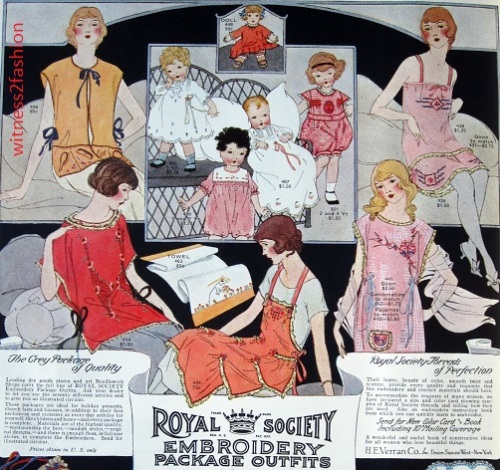
An ad for Royal Society embroidery “package outfits;” Delineator, November 1924, p. 78. It seems that these were kits, ready to be embr0idered.

The variety of lingerie — and the names — from Butterick’s 1924 underwear patterns is amazing to me. It’s a specialized area that doesn’t really make me want to hit the reference books. However, for those of you who love or collect vintage undies, here are some images and pattern descriptions from 1924 and 1925.
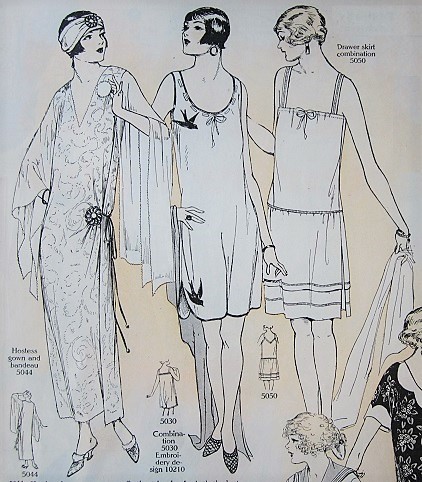
The two garments on the right are called “combinations;” The one with birds is Butterick 5030; the one on the far right (“drawer skirt combination”) is Butterick 5050. Delineator, February 1924.
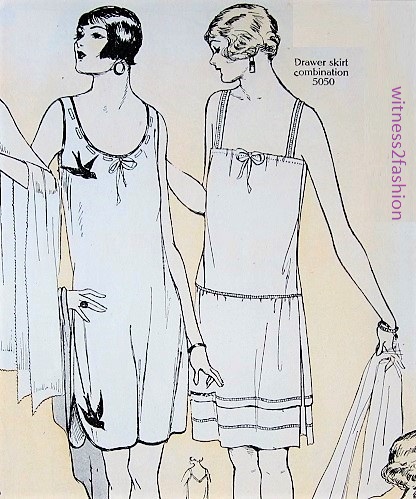
A closer look at combination 5030 and drawer skirt combination 5050. No. 5030 seems to form into legs, but in fact the front and back hems are connected with a strip of fabric.

The back view implies that 5050 has a crotch strap running from front to back [and closed with buttons]. The text doesn’t really explain how number 5050 is constructed. “Tub” means “washable.” 5030 is a “dainty step-in combination chemise and drawers.”

These two patterns were illustrated repeatedly, but not together, with varied descriptions. I arbitrarily referred to this pale green one-piece as a “teddie” in a previous post, but I’m no longer sure that’s the correct term. It might be “combinations” or a “step-in” chemise. [See comments.]

This pale green, tucked teddy [or step-ins? or combinations? ] has a crotch strap, barely visible. It stops at the edge of the netting lace. You can see a straight line of stitching where it attaches to the garment, about an inch or so above the lace trim.

Vintage step-ins; the crotch has no buttons, the sides are open below the waist, and they would not be easy to step into, because your hips would have to fit through the waist — or, rather, the waist has to be as big as your hips.

Detail of leg on vintage combination step-ins. It would not be easy to answer the call of nature while wearing these.
[End of edited section….]

Butterick “Step-in” 4112 and “Envelope Chemise” 5059, pictured in Delineator, June 1924. You can see the button crotch in both of these. But how does a “combination” differ from a “step-in?” Or a “step-in combination” as it says here?
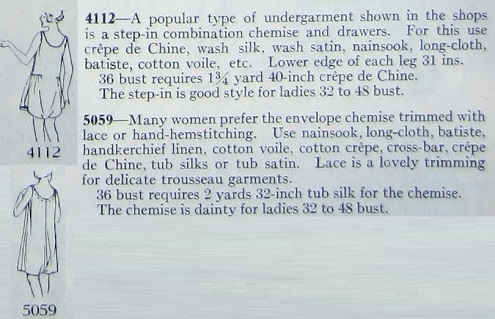
The very low crotch looks uncomfortable to a woman who grew up wearing knitted briefs, but there was probably a notion that “the parts need airing,” as was sometimes claimed by wearers of kilts.

Butterick “cami-knickers” 5124 with “envelope chemise” 5059. Delineator, April 1924.

Munsingwear offered this unfussy, step-in version of a “woven union suit with closed gore, step-in style.”

Ad for Munsingwear knitted underwear for women; Delineator, June 1924. If the crotch strap was close to the hem, that “wide opening at the side” [see below] would be needed.

Below, a pair of “knickers” held by a young woman wearing an “envelope chemise.”

The model wearing “envelope chemise” 4137 is holding a pair of “knickers,” pattern 3197. In the U.S., “Knickers” sometimes referred to undergarments in January 1924, and still does in England. Delineator, January 1924. [And Delineator was published in England as well as in the U.S.]
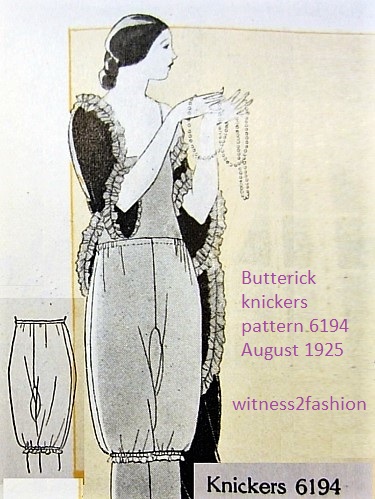
Butterick knickers pattern 6194 was brand new in August of 1925 — and these knickers are definitely underwear.
But, to add to my confusion, Butterick offered knicker pattern 3496 as outdoor wear, also in the summer of 1925.

Woman golfer wearing knicker pattern 3496, from Delineator, July 1925, p. 35.
The number series suggests knicker pattern 3496 was issued back in 1922 or 1923 and still popular in 1925.

Butterick pattern 3496, knickers to wear for sports. Delineator, January 1925, p. 34.
Knickers? Bloomers? Drawers?

Butterick pattern 4974, for step-in “Drawers” was probably issued in 1923 or early 1924. These have elastic in the waist, making them easy to step into and draw up.

Butterick “step-in drawers” pattern 5564, from October 1924. “Under the new narrow dresses you should wear lingerie cut on correspondingly narrow lines.”
This set (“chemise and drawers”) was featured in June, 1924.
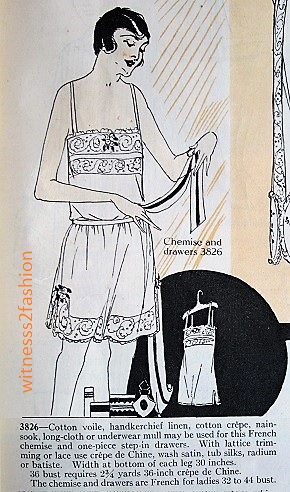
A “French chemise” and one-piece step-in drawers, Butterick 3826, illustrated in June 1924. I’m guessing that the pattern contained a camisole-and-drawers version and an all-in-one version as shown at right. “Width at bottom of each leg 30 inches.”
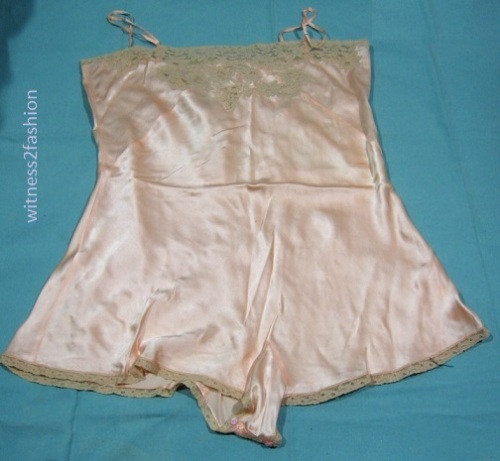
This vintage step-in [1/17/18 edit: Combination] chemise would look different on a human body. This silky beauty has no waist seam. It does have a button crotch.

“Drawer-skirt combination” (5050, at left,) camisole 4957, and envelope chemise 5059. Delineator, May 1924.
This lovely vintage set of camisole and drawers shows its button crotch clearly:

This vintage set — I love the contrasting lace and embroidery color — has a separate camisole and [not step-in] drawers. Since the waist is not elastic, the “drawers” need to have a button crotch.

Detail from Royal Society ad, November 1924. The camisole costs $1.25 and the drawers [?] cost $1.50.

Butterick 4974 was called ” step-in drawers” in January 1924. They have an elastic waist, so they might not need a button-crotch. For hips 35″ to 52.”

A new set of step-in drawers “in a skirt effect” is illustrated in October, 1924: Butterick pattern 5565. These would need a strap-type crotch of some kind. [They don’t have separate legs, so why are they called “drawers?”]

Bloomers, Butterick 5705; Delineator, March 1925. To read about boneless corselettes, click here.
But bloomers, like knickers, could also be outerwear:

Butterick “combination” 5030 (again) and bloomers for a little girl [or girls 2 to 16 years!] Butterick 5065. Delineator, March 1924. These bloomers are attached to an underbodice, very practical for the years when little girls have tummies bigger than their hips. [I remember needing suspenders on my skirts in first grade….]

Often, “bloomers” were intended to be seen, and were worn by almost all girls as part of their gym suits, or for any active pursuits. The middy blouse would cover the underbodice:

Middy blouse 3849 was a classic. I have photos of my aunt and friends graduating from high school wearing a middy-blouse-plus-white-skirt uniform in 1917. Gym bloomers (“for girls or misses 2 to 18”) were very full, often pleated. Delineator, February 1924. The Vintage Traveler shared a whole middy catalog from the 1920’s here.
Did I learn anything from this adventure in undergarment nomenclature? Only to avoid making absolute pronouncements about bloomers, knickers, drawers, teddies, chemises, camisoles, combinations, and step-ins! [Please see helpful comment from thevintagetraveler!]

Fascinating! I wonder if part of the language confusion was that underwear styles were in flux and even the designers were just figuring out what to call it.
Good point. As with brassieres, the shape of some garments changed drastically, but the old name was passed on to the new object. Not to mention the confusion of Delineator trying to describe things for both British and American readers. (In England, a “vest” is an undershirt, and “pants” are underpants, not trousers….)
Here’s my take, and I could be wrong. I’ve been looking at catalogs from 1918 through 1925, and I’ve found all the terms you’ve mentioned. I have not found anything referred to as a “teddy”. We used that term in the 1980s when the camisole/panty combination had a comeback. I don’t know if it was used in the 1920s.
From what I can tell using my own sources, an envelope combination is one that has the buttoning crotch flap, sort of in the way an actual envelope has a flap to close it. So the pictured green suit is an envelope combination.
Step-in combinations are different in that they have to be literally stepped in to. The partition between the legs is sewn rather than buttoned and so the garment cannot be pulled over the head and onto the body. It’s easy to see why the combination was starting to be divided in two pieces. How on earth would one be able to use the toilet without completely undressing?
For the life of me, I can’t see why Butterick 6194 was called knickers. I’ve read all kinds of explanations about why Americans used bloomers/panties/stepins while the British called the same garment knickers. From what I can see, “knickers” was rarely used in the US to denote an undergarment. But from your example we can see that it was, on occasion, used in that way.
As for outerwear, bloomers are full, and they close at the bottom with elastic. Knickers are much less full, and close at the knees with a band that buttons.
Thank you — I think that “step-ins” that could not be unfastened for a trip to the bathroom must have been awful — I haven’t forgotten the blouses and playsuits of the early 70’s. Perhaps the underwear “knickers” really were a product of the Butterick Company’s having offices — and readers — in England, France, Germany, etc. The information about knee-band versus elastic is very helpful.
My grandmother (born in 1902) wore something that looked like a less full version of the drawers that she called drawers, but were sold as pettipants. She wore them her whole life, even when they got really hard to find in the ‘80s. So guess whose job it was to find them? :). She was a big proponent of “airing out” the nether regions.
Enjoyed this post. Lovely illustrations and vintage garments.
This subject always makes me think of Cheaper by The Dozen – when the eldest daughter buys teddies and silk stockings.
I have a high school home economics book, Fabric and Dress, copyright 1931, which includes a table of materials suitable for underwear. It lists slips, teddies, step-ins, bloomers, shorts, brassieres, shirts, union suits, pajamas and gowns. Shirts and union suits are listed as uses for stockinette, and it is indicated just prior to the table that pajamas and gowns are nightwear. There are also references to previous styles of undergarments: Petticoats, camisoles, and this interesting one “Pettibockers (full bloomers drawn in below the knee) were popular when skirts were long. The style of short skirts changed this undergarment, by shortening it and taking out some of the fullness.”
I also found it interesting that in the chapter which goes over a bit of fashion history, with an emphasis on the “follies of fashion”, (i.e., 18th century headdress, Elizabethan ruffs, 1860 hoopskirts) there is a reference to “Another more recent fashion, which will probably seem as absurd as many of these when it becomes long out-of-date, is the very short skirt of 1928 and 1929, which was about three inches above the knee.”
Your 1931 Home Ec book sounds like a real find — especially that mention of skirts three inches above the knee. It surprised me, but I guess we ought to trust a reference to the styles of just three or four years earlier. It’s time for me to re-read Cheaper by the Dozen, since that would be an early reference to Teddies in the U.S. — although it wasn’t published till 1948. Thanks for contributing to this conversation!
It is a great book. I was surprised by just how short the skirts were, also. Teddie must have come into use sometime prior to 1931, as it is used in a fashion which indicates that students would be very familiar with the term. Guess I should say, it is a U.S. published book.
Cheaper by the Dozen is definitely worth a re-read, a wonderful story, I enjoyed it so much as a child. Though I admit I usually stop reading before the end. I always found it too sad after my father died suddenly of a heart attack.
It’s wonderful how much we learn from reading fiction. I’m sorry to hear about your loss; the actor Jeremy Brett, speaking of the death of his wife Joan, said, “People say ‘you’ll get over it.’ You get used to it, but you never get over it.” Sadly true.
Thank you. It happened many years ago.
It is very true. I’m grateful I had already learned that, and did not feel quite so at sea when well-meaning people said that sort of thing when my mother passed recently. It is very hard to lose them with no warning.
Pingback: Quick Post: Theda Bara’s Bloomers | witness2fashion
Pingback: 1924年頃のエンベロープ・キャミソールや他の下着 | モードの世紀
Your posts have gotten me interested again in the different terms and when they were in use. Here is an earlier (October 31, 1918) reference to teddies, in “The Kaufmann Store” ad, near the top right of the page seven image. It also mentions pettibockers and a few other items.
https://virginiachronicle.com/cgi-bin/virginia?a=d&d=RTD19181031.1.7
Wow! These Vanity Fair lingerie ads you are finding are a treasure trove of vocabulary information. This ad from a Virginia newspaper not only mentions “Pettibockers” (I’m starting to suspect that they were a Vanity Fair invention) but contributes to our discussion with a listing for “Envelopes or teddies,” showing that “teddies” was a term in use in the U.S. by 1918. It also broadens the meaning of “union suits” (in the 1880s a knit garment my family called “long johns”) by offering one with a camisole top, silk ribbon straps and “Overlap” open crotch. Since this originally started as a discussion of undergarment vocabulary in the mid 1920’s, I haven’t explored my Perry Dame catalog for 1917, or gone wandering through the Sears catalogs for World War I era undies. Obviously, the terms that were still confusing in the 1920’s drew heavily on names from the previous decades. What fun! Brava, Dee!
I was hoping that I hadn’t gotten out of hand posting links. Glad you enjoyed them, and hope you have fun looking through your catalogs.
I agree that Vanity Fair seems to have originated pettibockers. And neglected to trademark it, judging by later ads. Don’t know if you saw the links in the comment I left on the Theda Bara post. I was tickled to find the Dolly Sisters modeling them. I found an earlier reference, (October 5, 1917) with a very thorough description of them, which mentions they were “A new undergarment of silk jersey, designed for women who skate, dance, or do active war work.”
https://chroniclingamerica.loc.gov/lccn/sn84023963/1917-10-05/ed-1/seq-7/#date1=1789&sort=date&date2=1949&words=Pettibocker&searchType=basic&sequence=0&index=0&state=&rows=20&proxtext=pettibocker&y=0&x=0&dateFilterType=yearRange&page=1
As for teddies, I found many other earlier references. I’ve included a link to a 1914 ad with cute illustrations (though it isn’t absolutely clear if teddies themselves are illustrated). I then came across information that the term originated with a man named Theodore Bear. There weren’t any references cited, but further digging makes it seem more likely. It looks like it was a fairly late entry in the “Teddy Bear” craze. There were “Teddy Bear” suits for children earlier in the century. And I found a few otherwise ordinary women’s suits or coats advertised as “Teddy Bear”. Apparently a Chicago garment manufacturer named Theodore Bear popularized the term “Teddy Bear” for the undergarment. There was a lot of information at a rather unexpected source (a sports and pop culture blog). The earliest reference to the undergarment I can find so far, is in the January 17, 1913 newspaper mentioned in the blog post.
https://chroniclingamerica.loc.gov/lccn/sn83045462/1914-01-15/ed-1/seq-17/#date1=1789&sort=date&rows=20&words=corset+Teddy&searchType=basic&sequence=0&index=9&state=&date2=1949&proxtext=teddy+corset&y=0&x=0&dateFilterType=yearRange&page=2
https://esnpc.blogspot.co.uk/2016/05/teddy-bears-and-teddies-surprisingly.html
Click to access seq-5.pdf
My family was still using the term “long johns” in the 1980s and 90s, though by that time we also applied it to sets with separate tops & bottoms.
Thanks for the prompt for some enjoyable research.
And that ad refers to “knickerbockers” instead of “knickers. ” You are a whiz at searching old newspaper ads!
Pingback: Three Eras of Ladies’ Changing Underwear Styles – Part Two, 1920s and 1930s | Seam Racer
Pingback: Underneath Those Twenties’ Fashions | witness2fashion
The low crotch of these underthings might seem breezy to us now, but compared to the open crotch drawers of just a few years earlier they were downright enclosed.
Yes, it’s odd to realize that Queen Victoria wore crotchless drawers like these.
Pingback: エンベロープ・キャミソール ほか:バタリック 1924年頃 – 遊民大学
Pingback: エンベロープ・キャミソール ほか:バタリック 1924年頃 | 遊民大学